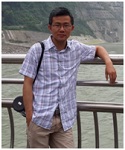| Biography | |
|---|---|
 Prof. Junqiao Ding Changchun Institute of Applied Chemistry, Chinese Academy of Sciences, China |
|
| Title: New applications of poly(arylene ether)s in organic light-emitting diodes | |
| Abstract:
Since 1967, poly(arylene ether)s (PAEs) have emerged as one of the most widely-used engineering plasticsdue to their high thermal and oxidative stability, good mechanical strength, superior electrical insulating ability and high glass transition temperatures.It should be noted that their applications can be newly extended from engineering plastics to optoelectronic functional materialsaccording to several issues as followed:(i)Theintrinsicthermal and morphological stability is beneficial for the achievement of long-term devices. (ii)Unlike conventional π-conjugated polymers prepared through transition metal catalyzed cross-coupling reactions, PAEs can be synthesized by means of base catalyzed nucleophilic aromatic substitution polymerization. Simple work-up of washing by water and precipitating in poor solvents can readily afford the desired polymer with high purity for use in optoelectronic devices,free of any residual catalyst contamination. (iii) PAEs possess well-defined conjugated moieties and localized excited state between two saturated oxygen atoms, so that their optical properties can be easily modulated to realize wide band-gap blue emission. Herein, I will talk about our efforts to develop efficient PAEs based lighting emitting polymers, which include fluorescent polymers, phosphorescent polymers and thermally activated delayed fluorescent (TADF) polymers.
| |
| Biography:
Dr. Junqiao Ding received his BS degree from Wuhan University of Technology in 1999 and gained his PhD degree from Changchun Institute of AppliedChemistry, CAS, in 2007 under the supervision of Prof. Lixiang Wang. After graduation, he joined the same institute as a research fellow and later was promoted as a professor in 2014. During 2010-2011, he performed postdoctoral work at the University of New Mexico. His research expertise is in solution-processed organic optoelectronic materials for flat-panel full-color displays and solid-state lightings. He has co-authored over 100 papers in refereed journals (over 3200 citations with h-index 31), including Angew. Chem. Int. Ed., J. Am. Chem. Soc., Adv. Mater., Chem. Sci.. Prof. Ding was honored with a Natural Science Academic Achievement Award (2011 and 2013, Jilin Province), Science & Technology Progress Award (2012, Jilin Province) and an Outstanding Young Scholar (2013, NSFC).
| |
